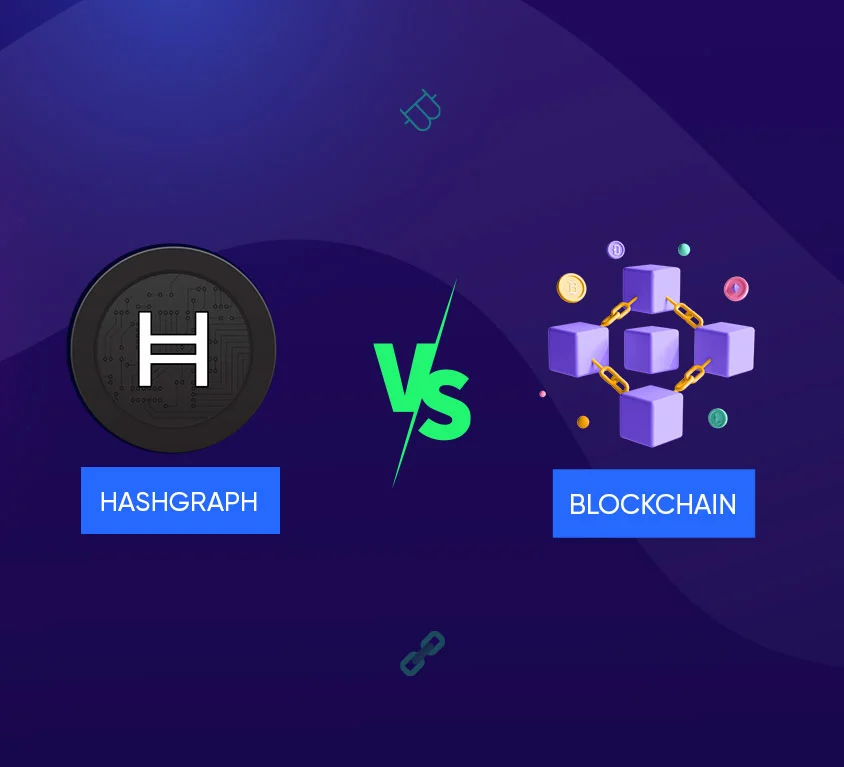
Introduction
Web3 & Blockchain Consultancy :
Hashgraph vs Blockchain: A Comprehensive Comparison
In the world of decentralized technologies, the clash between Hashgraph vs blockchain takes center stage. However, Blockchain technology revolutionized decentralized ledgers, transforming centralized systems. It introduced blocks connected by cryptographic hashes, providing a transparent, untrustworthy framework for peer-to-peer transactions. The distributed nature and consensus techniques established a decentralized future. Furthermore, The increasing demand for scalable, efficient decentralized solutions led to the development of Hashgraph, a novel distributed ledger technology offering enhanced scalability, speed, and fairness, reshaping the decentralized technology landscape. As we are going to have a detailed exploration of these two technologies, we will dissect their architectures, functionalities, and implications. This in-depth analysis and comparison aim to provide a clear understanding of Hashgraph vs Blockchain and define their roles in the decentralized systems.What is Blockchain?
What is Hashgraph?
Hashgraph is a technology that works in tandem with blockchain to accomplish distributed ledger goals. It differs from blockchain in that there won’t be a chain of blocks since hashgraph technology doesn’t form blocks. The gossip method is another way to create a distributed ledger based on consensus. Hashgraph accomplishes this by using the gossip of gossip methodology. Hashgraph asserted to take the place of blockchain and all of its shortcomings. However, it appears to be limited to working on private networks, and there is currently no cryptocurrency that runs on a hashgraph. So it’s like comparing oranges and apples.Hashgraph vs Blockchain: Key Differences
Features |
Blockchain |
Hasgraph |
|---|---|---|
Consensus Mechanism |
Mining (Proof-of-Work or Proof-of-Stake) | Gossip about Gossip |
Transaction Processing |
Sequential grouping into blocks | Recorded in a Directed Acyclic Graph (DAG) |
Transaction Speed |
Slower due to block confirmation times | Faster due to simultaneous processing in DAG |
Scalability |
Limited scalability as block size increases | High scalability, can handle more transactions |
Fairness |
Relies on the robustness of cryptographic hashes | Advanced consensus mechanism for greater security |
Adoption and Maturity |
Potential for mining centralization | Relatively new and experimental |
Use Cases |
Cryptocurrencies, Smart Contracts, Supply Chain | Potential for various applications, but not widely adopted |
Known Challenges |
Scalability, Energy Consumption (Proof-of-Work) | Limited real-world use, experimental nature |
Future Outlook |
Ongoing evolution and improvements | Uncertain, as it is still an emerging technology |
Detailed Comparison of Hashgraph vs Blockchain
Blockchain’s decentralization, exemplified by public blockchains like Ethereum and Bitcoin, creates a trustless, censorship-resistant environment through consensus mechanisms. However, Hashgraph, designed with decentralization in mind, may not achieve the same level due to node communication nuances.-
Transparency
Blockchain’s transparency allows for transaction validation and asset movement monitoring, making it ideal for supply chain management and finance. Hashgraph, on the other hand, prioritizes privacy and security, presenting challenges in transparency due to its closed nature.
-
Adoption
Blockchain’s widespread adoption across industries demonstrates its success, with a mature ecosystem offering numerous tools, services, and applications. Hashgraph, a new entrant, faces adoption challenges due to the limited availability of tools and services.
-
Network Effects
Blockchain’s network effect drives its development, fueled by decentralized applications and innovation. However, Hashgraph, a relatively new technology, faces challenges in attracting users and developers due to its smaller user base.
-
Navigating Challenges
Blockchain faces challenges like scalability, energy consumption, and potential centralization, questioning its long-term sustainability. This section explores scalable and environmentally friendly blockchain ecosystems, while Hashgraph presents a promising alternative, highlighting its challenges for specific applications.
Challenges in Blockchain and Hashgraph:
Blockchain |
Hashgraph |
|---|---|
| Scalability Concerns | Limited Adoption and Maturity |
| Substantial Energy Consumption | Production Environment Viability |
| Potential Centralization | Potential Network Effects |
| Slower Transaction Speed | Fewer Tool and Service Availability |
Benefits Of Blockchain & Hashgraph
Understanding the unique benefits of each technology is essential for making informed decisions based on specific use cases and requirements in the evolving landscape of decentralized technologies.Blockchain
- Blockchain establishes a decentralized network, ensuring that no single entity has control, fostering trust and transparency.
- Blockchain technologies, like Bitcoin and Ethereum, have a track record of successful implementations, widespread adoption, and a mature ecosystem.
- The transparent nature of blockchain allows anyone to verify transactions and track the movement of assets on the network.
- Blockchain benefits from significant network effects, with a large and growing user base driving innovation and adoption.
- Blockchain finds applications in various industries, from cryptocurrencies to smart contracts and supply chain management.
- The consensus mechanisms, such as proof-of-work and proof-of-stake, contribute to the security and integrity of the blockchain network.
Hashgraph
- Hashgraph’s directed acyclic graph (DAG) structure offers inherent scalability advantages over traditional linear blockchains.
- The “gossip about gossip” consensus mechanism, coupled with asynchronous Byzantine Fault Tolerance, provides an efficient way to achieve agreement on the order of transactions.
- Hashgraph’s consensus mechanism eliminates the need for energy-intensive mining processes, potentially making it more environmentally friendly.
- Hashgraph’s gossip protocol allows for quicker transaction processing, potentially outpacing the transaction speed of traditional blockchains.
- Hashgraph’s consensus mechanism is designed to ensure that all participants have an equal opportunity to contribute, potentially reducing certain types of unfairness.
- Hashgraph presents a novel and innovative approach to distributed ledger technology, exploring new possibilities beyond traditional blockchains.